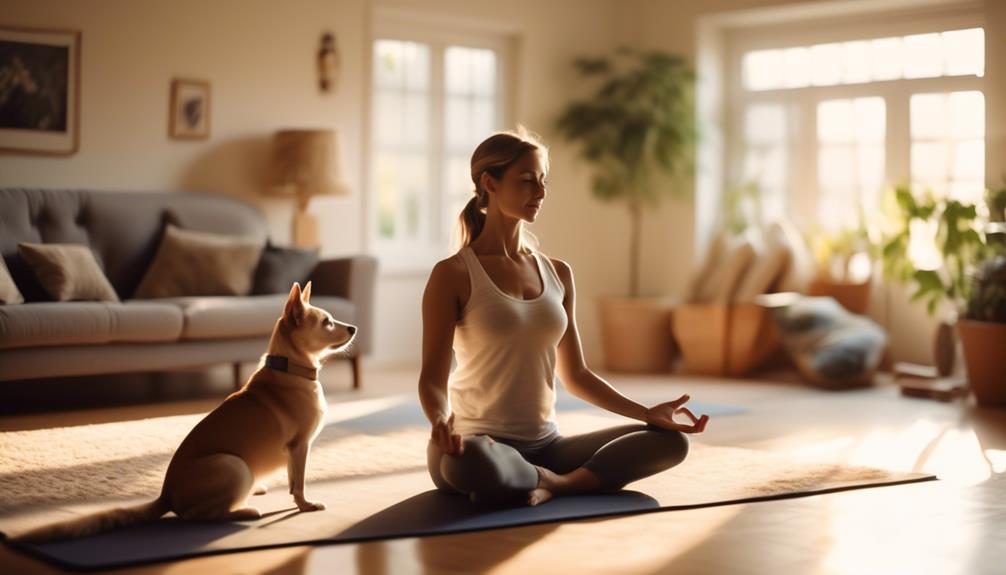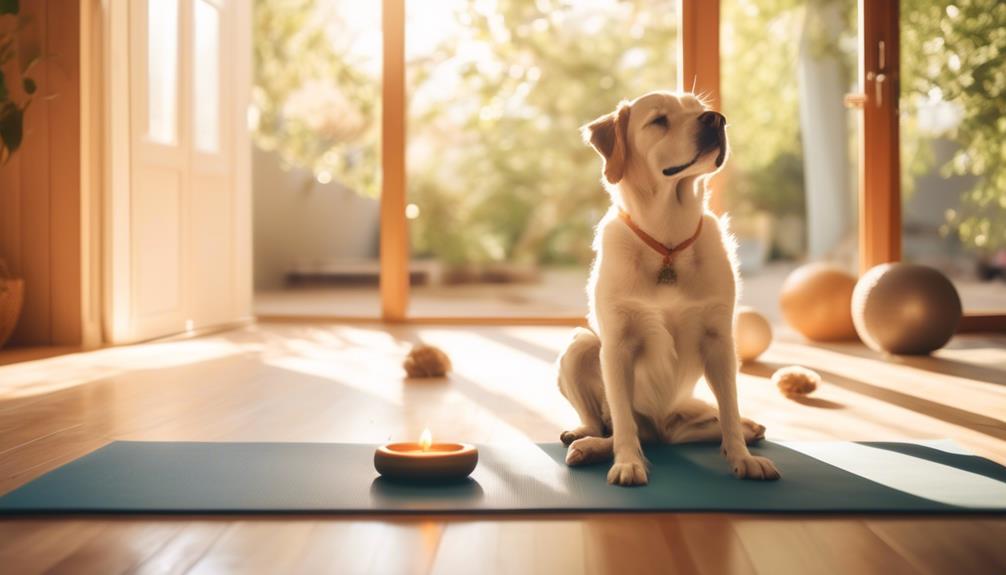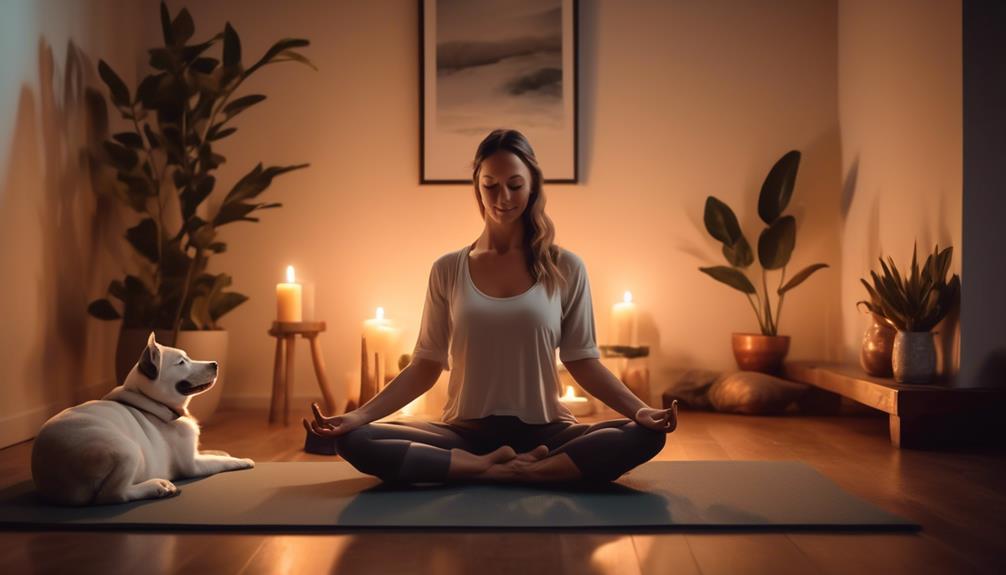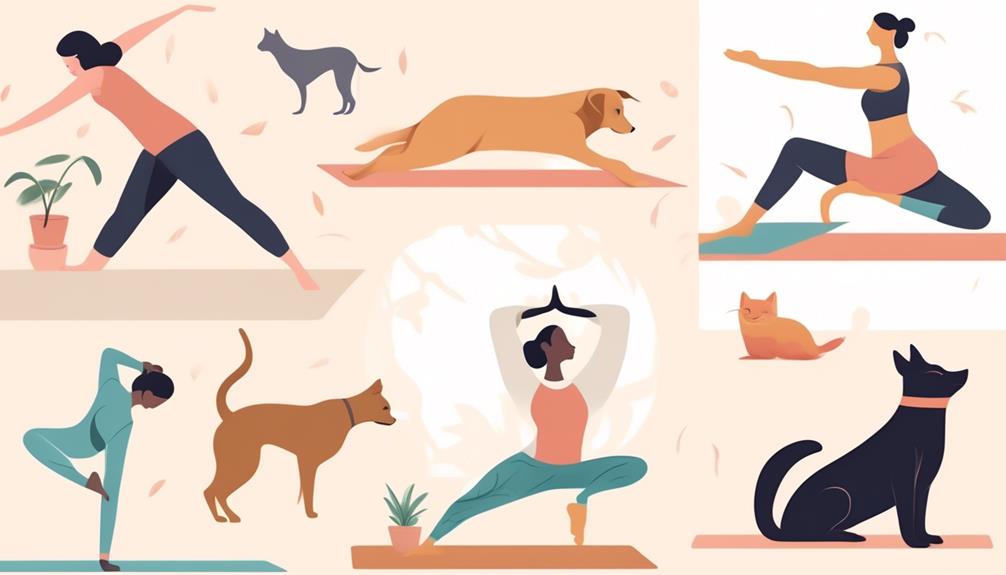Does Yoga Enhance a Pet's Mood and Behavior?

Yoga has been found to be beneficial for pets in several ways. One study showed that practicing yoga with dogs helped decrease their stress levels. Another study found that cats who participated in yoga sessions exhibited reduced anxiety and improved behavior. In addition to reducing stress and anxiety, yoga can also help pets relax by promoting deep breathing and stretching. This can lead to a greater sense of well-being and overall improved mood. Overall, the evidence suggests that incorporating yoga into a pet's routine can have positive effects on their mood and behavior.
Key Takeaways
- Pet yoga has scientifically-backed benefits for improving mood and behavior in pets.
- Yoga reduces stress and anxiety in pets, leading to improved emotional balance and behavior.
- Practicing yoga with pets promotes bonding and trust, particularly for rescue pets or those with trust issues.
- Regular yoga practice enhances flexibility, strength, and coordination in pets, resulting in better behavior.
The Benefits of Yoga for Pets
The practice of yoga offers numerous benefits for pets, improving their mood and behavior through scientifically-backed methods.
Yoga for cats and dogs has gained popularity in recent years, as pet owners seek natural and holistic ways to enhance the well-being of their furry companions.
One of the key benefits of pet yoga is stress reduction. Just like humans, pets can experience stress and anxiety. Yoga provides them with a calming and soothing environment, allowing them to release tension and find inner peace. This can lead to a significant improvement in their overall mood and behavior.
Additionally, pet yoga helps to enhance flexibility and strength. Through gentle stretching and movement, pets can improve their range of motion and muscle tone. This is particularly beneficial for older pets or those recovering from injuries, as it can help to alleviate pain and improve mobility.
Moreover, practicing yoga with pets promotes bonding and connection. It allows for quality time spent together, creating a sense of trust and companionship. This can be especially beneficial for rescue pets or those with trust issues, as it helps to build a positive and loving relationship.
Understanding the Connection Between Yoga and Pet Behavior

Pets who regularly practice yoga can experience significant improvements in their behavior, as the connection between yoga and pet behavior is becoming increasingly understood. Here are four key points to help us understand the science behind pet yoga:
- Stress Reduction: Yoga has been shown to reduce stress in humans, and the same principle applies to pets. Engaging in yoga poses and focusing on breathing helps pets to relax and release tension, leading to calmer behavior.
- Increased Flexibility and Balance: Regular yoga practice improves flexibility and balance in pets, just as it does in humans. This enhanced physical ability can contribute to better coordination and overall improved behavior.
- Mind-Body Connection: Yoga encourages pets to be more aware of their bodies and their surroundings. By cultivating this mind-body connection, pets become more in tune with their emotions and are better equipped to manage them, resulting in more balanced behavior.
- Bonding and Socialization: Participating in yoga with their owners creates an opportunity for pets to bond and socialize. This positive interaction helps to build trust and strengthen the human-animal relationship, which can have a positive impact on behavior.
Understanding the connection between yoga and pet behavior is crucial in harnessing the benefits of pet yoga for overall pet health and well-being. By incorporating yoga into their routine, pet owners can promote positive behavior and enhance the quality of life for their furry companions.
How Yoga Can Reduce Stress in Pets

Yoga has been shown to be an effective stress reduction technique for humans, and the same benefits can be extended to pets.
Engaging in yoga exercises can have calming effects on pets, helping them relax and reduce stress levels.
This reduction in stress can have a positive impact on their overall behavior, promoting a sense of well-being and emotional balance.
Stress Reduction Techniques
By incorporating yoga into their routine, pet owners can provide their furry companions with effective stress reduction techniques.
Yoga has been shown to have numerous benefits for humans, including stress relief and anxiety management. It turns out that these benefits can also extend to our pets.
Here are four stress reduction techniques that yoga can offer to our furry friends:
- Deep Breathing: Yoga encourages deep, slow breaths which can help calm the nervous system and reduce stress in pets.
- Stretching: Just like humans, pets can experience muscle tension and stiffness due to stress. Yoga poses can help release tension and promote relaxation.
- Mindfulness: Practicing mindfulness during yoga can help pets focus their attention on the present moment, reducing anxiety and promoting a sense of calm.
- Bonding: Engaging in yoga with our pets strengthens the human-animal bond, providing a sense of comfort and security.
Incorporating yoga into a pet's routine can be a valuable tool for managing stress and promoting overall well-being.
Calming Effects of Yoga
The calming effects of yoga on pets have been scientifically proven, demonstrating its ability to reduce stress and promote relaxation.
Yoga for anxious pets can be particularly beneficial in providing them with a sense of calm and tranquility. When pets are anxious, their bodies produce stress hormones such as cortisol, which can lead to various behavioral issues.
Engaging in yoga helps to activate the parasympathetic nervous system, responsible for the body's relaxation response. This activation results in a decrease in stress hormones and an increase in feel-good neurotransmitters like serotonin and dopamine.
Similarly, yoga for hyperactive pets can help channel their excess energy into a focused and controlled state. The slow movements and deep breathing techniques in yoga help pets to find a state of balance and inner calm, reducing their overall anxiety levels and improving their overall well-being.
Positive Impact on Behavior
Pets who regularly practice yoga experience a significant reduction in stress levels, leading to positive changes in their behavior. Yoga has been found to be an effective tool for anxiety relief in both humans and animals. When it comes to pets, the calming effects of yoga can be especially beneficial for those with hyperactive behavior.
Here are four ways in which yoga can positively impact a pet's behavior:
- Improved focus: Regular yoga practice helps pets develop better concentration skills, allowing them to focus on tasks and commands.
- Reduced aggression: Yoga promotes relaxation and helps pets manage their emotions, leading to a decrease in aggressive behavior.
- Enhanced self-control: By practicing mindfulness and breathing exercises, pets learn to control impulsive behaviors and make better choices.
- Increased socialization: Yoga classes often involve interaction with other pets, fostering socialization skills and reducing anxiety in social situations.
Promoting Relaxation Through Pet Yoga

Promoting relaxation through pet yoga involves incorporating calming poses specifically designed for pets. These poses help to reduce stress and anxiety, promoting a state of relaxation in animals.
The benefits of pet yoga include improved overall well-being, better mood, and enhanced behavior. Additionally, engaging in pet yoga can also strengthen the bond between pet owners and their furry companions, as it provides an opportunity for shared relaxation and connection.
Calming Poses for Pets
Engaging in calming poses through pet yoga enhances relaxation and promotes a sense of tranquility for our furry companions. Pet owners can incorporate these calming poses into their pet's routine to help them achieve a state of calm and relaxation.
Here are four calming poses that can benefit pets:
- Child's Pose: This pose helps to stretch the spine and relaxes the mind. It can promote a sense of safety and security for pets.
- Cat-Cow Pose: This pose helps to release tension in the back and neck, promoting flexibility and relaxation in pets.
- Downward-Facing Dog Pose: This pose stretches the entire body and can help pets release pent-up energy and anxiety.
- Savasana (Corpse Pose): This pose allows pets to fully relax and let go of any remaining tension in their bodies.
Benefits of Pet Yoga
After incorporating calming poses into their pet's routine, pet owners can further enhance their furry companions' relaxation and well-being through the numerous benefits of pet yoga.
Pet yoga, also known as 'doga,' is a practice that combines traditional yoga poses with gentle stretching and massage techniques for pets. Yoga for cats and dogs has been shown to promote relaxation by reducing stress and anxiety levels. The slow movements and deep breathing involved in pet yoga help pets release tension and find a sense of calm.
Additionally, pet yoga can improve flexibility and mobility in pets, enhancing their overall physical well-being. Regular practice of pet yoga has also been linked to improved sleep patterns and increased bonding between pets and their owners.
Bonding Through Relaxation
Through the practice of pet yoga, pet owners can foster a deeper bond with their furry companions, promoting relaxation and overall well-being. Bonding techniques and relaxation techniques used in pet yoga can provide numerous benefits for both the pet and the owner.
Here are four key ways in which pet yoga promotes bonding and relaxation:
- Shared mindfulness: Practicing yoga together creates a shared experience of mindfulness and presence, allowing both the pet and the owner to connect on a deeper level.
- Physical touch: The gentle stretching and massage involved in pet yoga involve physical touch, which releases oxytocin, the bonding hormone, promoting a sense of trust and closeness.
- Calming environment: Pet yoga takes place in a calm and peaceful environment, providing a soothing atmosphere for both the pet and the owner to relax and unwind.
- Increased communication: Pet yoga encourages clear and intentional communication between the pet and the owner, enhancing their understanding of each other's needs and desires.
Enhancing a Pet's Mood With Yoga

Yoga has been shown to have a positive impact on a pet's mood, according to scientific research and evidence. Pet yoga techniques, specifically designed for our furry companions, can help alleviate anxiety and enhance their overall well-being. Just as yoga promotes relaxation and stress reduction in humans, it can have similar effects on pets.
Yoga for pet anxiety involves gentle stretches and movements that promote flexibility, balance, and relaxation. These techniques can help calm an anxious pet by releasing tension and promoting a sense of calmness. Deep breathing exercises, such as the 'Puppy Breath' technique, can also be incorporated to further enhance relaxation.
One of the key aspects of pet yoga is the bond it creates between the pet and their owner. Engaging in yoga together allows for quality time and shared experiences, strengthening the human-animal bond. This bond is essential for a pet's emotional well-being and can contribute to a happier and more contented pet.
Incorporating yoga into a pet's routine can provide numerous benefits, including increased relaxation, reduced anxiety, and improved mood. It's important to consult with a qualified professional or a certified pet yoga instructor to ensure that the techniques are appropriate for your pet's specific needs.
Introducing Yoga to Your Pet: Tips and Considerations

Building upon the benefits of pet yoga discussed earlier, introducing yoga to your pet requires careful consideration and a gradual approach to ensure a positive and successful experience. Here are four important tips and considerations to keep in mind when introducing yoga to your pet:
- Start with short sessions: Just like humans, pets need time to adjust to new activities. Begin with short yoga sessions, gradually increasing the duration as your pet becomes more comfortable. This will help prevent any feelings of overwhelm or anxiety.
- Use positive reinforcement: Reward your pet with treats or praise during and after each yoga session. This will create positive associations with the practice and encourage your pet to participate willingly.
- Be aware of your pet's limitations: Not all pets are physically capable of performing all yoga poses. Pay attention to your pet's comfort level and modify the poses accordingly. For example, older dogs may benefit from gentle stretching exercises rather than more demanding poses.
- Consult with a professional: If you're unsure about how to introduce yoga to your pet or if your pet has any underlying health conditions, it's best to consult with a veterinarian or a professional pet yoga instructor. They can provide guidance tailored to your pet's specific needs, ensuring a safe and effective practice.
Introducing yoga to your pet can be a wonderful way to enhance their overall well-being. By following these tips and considerations, you can create a positive and enjoyable yoga experience for your furry friend.
Exploring Different Yoga Practices for Pets

Different yoga practices tailored for pets can provide a wide range of physical and mental benefits, promoting their overall well-being. Incorporating yoga into a pet's daily routine can be a great way to enhance their mood and behavior. There are several different yoga poses that can be adapted for pets, allowing them to experience the benefits of this ancient practice.
One popular yoga pose for pets is the downward-facing dog. This pose helps to stretch and strengthen their muscles, improving their flexibility and range of motion. It also helps to calm the mind and reduce anxiety, promoting a sense of relaxation and well-being.
Another beneficial pose for pets is the cat-cow stretch. This pose helps to release tension in their spine and improve their posture. It also stimulates their digestive system, aiding in proper digestion and preventing gastrointestinal issues.
Incorporating yoga into a pet's daily routine can be as simple as setting aside a few minutes each day to practice these poses. It's important to start slowly and gradually increase the duration and intensity of the practice as the pet becomes more comfortable.
Frequently Asked Questions
Can Yoga Be Harmful to Pets?
Yoga can have potential risks for pets. It is important to take precautions and ensure the safety of the animal. Consulting with a veterinarian and using proper techniques can help minimize any harm.
How Often Should I Practice Yoga With My Pet?
Regularly practicing yoga with a pet has numerous benefits. It can enhance their mood and behavior, promoting relaxation, flexibility, and bonding. Consistency is key, so aim for at least a few sessions per week.
Are There Any Specific Poses That Are Particularly Beneficial for Pets?
Yoga for pets offers numerous benefits, including improved mood and behavior. Certain poses can be particularly beneficial, such as downward dog for stretching and relaxation, and cat-cow for spinal flexibility.
Can Yoga Help With Behavioral Issues in Pets?
Yoga can indeed help with behavioral issues in pets. It has been shown to reduce pet anxiety and improve their mood. Additionally, the benefits of pet yoga in training are well-documented, making it a valuable tool for pet owners.
Is It Necessary to Attend a Yoga Class Specifically Designed for Pets, or Can I Practice at Home With My Pet?
Practicing yoga at home with a pet can provide numerous benefits. While attending a class designed for pets may offer additional guidance, practicing at home can enhance the bond between owner and pet, promote relaxation, and improve overall well-being.









